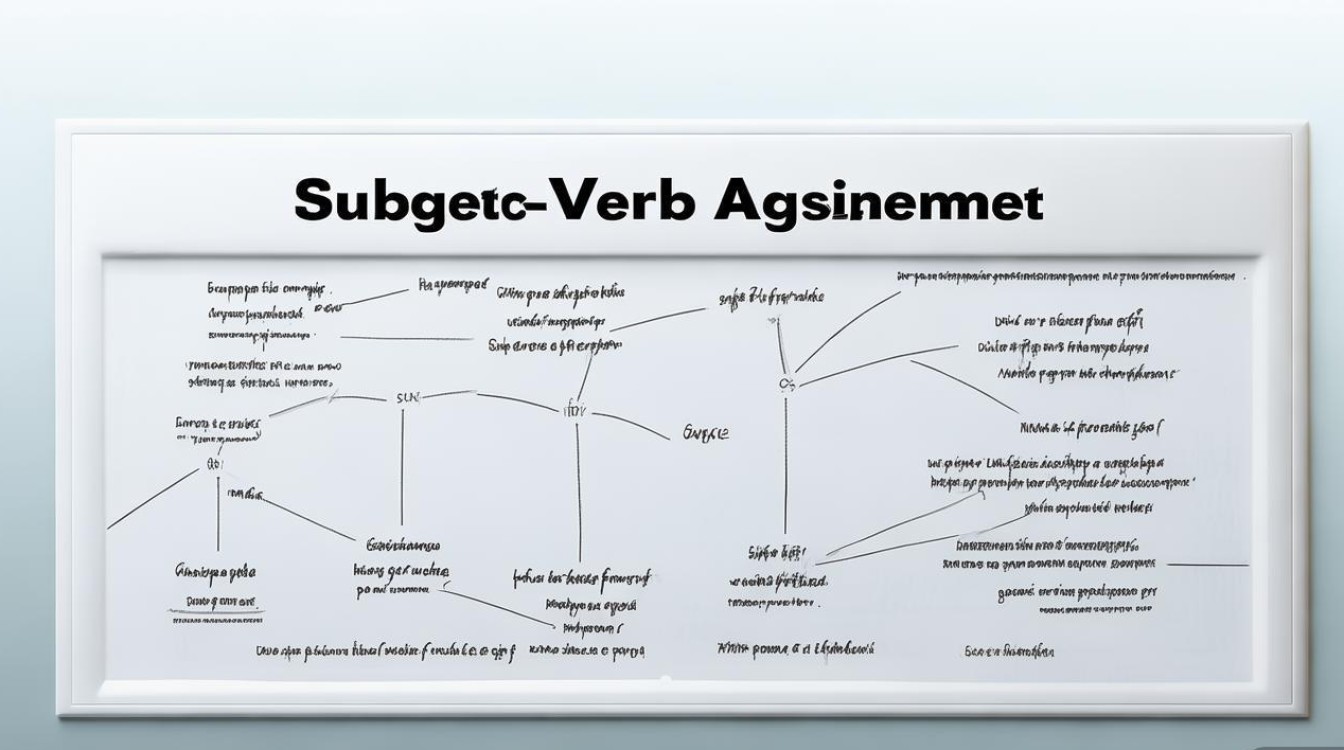主谓一致 思维导图
中心主题:主谓一致

核心原则: 句子的谓语动词必须在“人称”和“数”上与它的主语保持一致。
第一分支:基本规则
-
1 单数主语 + 单数动词
- 规则: 主语是单数,动词用原形或第三人称单数形式 (
-s或-es)。 - 示例:
- He works hard.
- The dog barks loudly.
- This book is interesting.
- One of my friends lives nearby.
- 规则: 主语是单数,动词用原形或第三人称单数形式 (
-
2 复数主语 + 复数动词
- 规则: 主语是复数,动词用原形。
- 示例:
- They work hard.
- The dogs bark loudly.
- These books are interesting.
- My friends live nearby.
-
3 “和”连接
- 规则: 由
and连接的多个主语,通常视为复数,用复数动词。 - 示例:
- Tom and Jerry are good friends. (两个人)
- Bread and butter is my breakfast. (看作一个整体概念)
- Iron and steel are essential materials. (两种不同材料)
- 规则: 由
第二分支:特殊情况 - 特殊主语
-
1 集体名词
- 规则: 根据其表达的是“整体”还是“成员个体”来决定动词的单复数。
- 示例:
- 作整体 (单数): The family is a big one. (强调家庭这个单位)
- 作成员 (复数): The family are watching TV. (强调家庭成员们)
- 常见集体名词: team, committee, government, class, audience, jury, public, staff.
-
2 每一个/任何一个/每一个
- 规则: 由
each,every,either,neither,one等词修饰的主语,或由each...and each...,every...and every...连接的主语,通常视为单数。 - 示例:
- Each student has a book.
- Every boy and every girl is invited.
- Either of the plans is acceptable.
- Neither of the answers is correct.
- 规则: 由
-
3 “或/要么...要么...”连接
- 规则: 由
or,either...or...,neither...nor...,not only...but also...连接两个主语时,动词与最靠近它的主语保持一致。 - 示例:
- He or I am wrong. (I am wrong)
- Neither the teacher nor the students are ready. (students are ready)
- Not only the students but also the teacher is excited. (the teacher is excited)
- 规则: 由
-
4 就近一致
- 规则: 除了上述情况,还有
there be句型和here/there + be句型也采用就近一致原则。 - 示例:
- There is a pen and two books on the desk. (a pen is...)
- Here comes the teacher and his students. (the teacher comes...)
- 规则: 除了上述情况,还有
第三分支:特殊情况 - 不可数名词与抽象概念
-
1 不可数名词
- 规则: 通常用单数动词。
- 示例:
- Water is essential for life.
- Information is power.
- The furniture in this room looks old.
-
2 数量词 + of 结构
- 规则: 由
a number of,a lot of,plenty of,some of,most of,half of,a majority of等短语修饰时,动词由of后面的名词决定。 - 示例:
- A number of students are absent. (students are...)
- The number of students is small. (The number is...)
- Most of the work is done.
- Most of the people are happy.
- 规则: 由
第四分支:特殊情况 - 特殊结构
-
1 “名词 + 介词短语”
- 规则: 谓语动词与前面的核心名词保持一致,而不是与介词短语中的名词。
- 示例:
- The list of items is long. (list is...)
- The quality of these products is high. (quality is...)
- A pair of shoes is under the bed. (pair is...)
-
2 定语从句
- 规则: 关系代词
who,which,that作主语时,其动词取决于它所指代的先行词。 - 示例:
- I have a friend who lives in Shanghai. (friend lives...)
- These are the books that were published last year. (books were...)
- 规则: 关系代词
-
3 “the + 形容词”
- 规则:
the + 形容词表示一类人时,视为复数;表示抽象概念时,视为单数。 - 示例:
- 指人 (复数): The rich are not always happy. (指富人这一类人)
- 指概念 (单数): The unknown is always frightening. (指未知这件事)
- 规则:
-
4 并列主语同指一人/物
- 规则: 由
and连接的两个名词,如果指的是同一个人或物,动词用单数。 - 示例:
- The poet and writer is coming to our school. (指同一个人,既是诗人也是作家)
- A cup and saucer is on the table. (指一套杯碟)
- 规则: 由
-
5 时间、金钱、距离等
- 规则: 当这些名词作为一个整体概念、一个单位时,谓语动词用单数。
- 示例:
- Five years is a long time.
- Ten dollars is too much for this shirt.
- Two miles is not a long walk.
第五分支:特殊情况 - 动词的特殊形式
-
1 不定式/动名词/名词性从句作主语
- 规则: 谓语动词通常用单数。
- 示例:
- To learn English is useful. (不定式)
- Swimming is my favorite sport. (动名词)
- What he said is not true. (名词性从句)
-
2 “分数/百分数 + of”
- 规则: 动词由
of后面的名词决定。 - 示例:
- Two-thirds of the surface of the earth is covered with water. (surface is...)
- 40% of the students are from the countryside. (students are...)
- 规则: 动词由
第六分支:实用技巧与记忆口诀
-
1 找准主语
- 技巧: 忽略插入语、介词短语、同位语等,快速找到句子的真正主语。
- 示例: The book, along with its characters, captures my imagination. (主语是 The book)
-
2 判断单复数
- 技巧:
- 看名词本身: 是否是可数名词的单/复数形式?还是不可数名词?
- 看修饰词: 是
a/an还是some/many?是each/every还是both/many? - 看逻辑: 集体名词表达整体还是个体?
- 技巧:
-
3 常见记忆口诀
- “单复就近原则”口诀: “或、要、非、但、or,就近原则来掌握。” (指
or,either...or...,neither...nor...,not only...but also...) - “就远原则”口诀: “with, together with, as well as, like, but, except, besides, plus”,这些词后面跟的名词不影响主语的单复数。
- 示例: The teacher, together with his students, is planting trees. (主语是 The teacher)
- “单复就近原则”口诀: “或、要、非、但、or,就近原则来掌握。” (指
掌握主谓一致,关键在于“找准主语,判断单复数”,先识别出句子的核心主语,然后根据主语的类型(单/复数/集体/不可数等)和句子的特殊结构,选择正确的动词形式,多练习,多总结,就能熟练运用。











